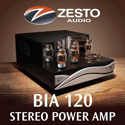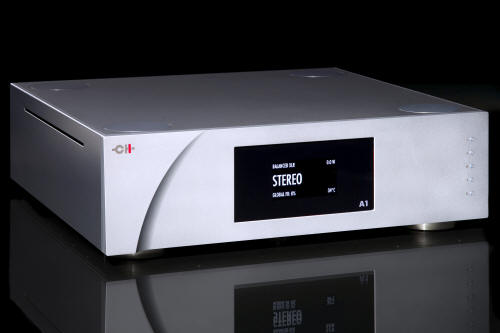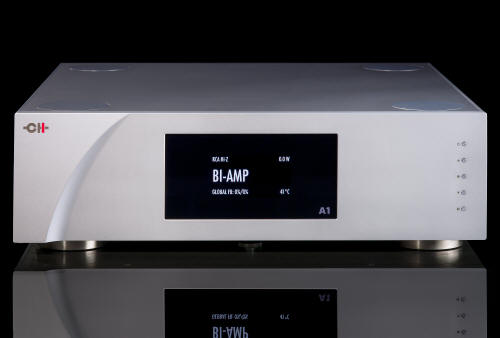|
|
You are reading the older HTML site
Positive Feedback ISSUE 73
ch precision A1 Amplifiers - Sonic Sculpture as reviewed by Marshall Nack
Speak with Authority Ah, there's that sound again. I catch it every now and then, either at audio shows or Hi-End dealer demos. Infrequently heard and unmistakable; it is the sound of authority. You can't miss it.
An Uncluttered Soundstage After adding a second CH Precision A1 amplifier to the system, something has happened to the soundstage. I'm listening to Byrd at the Gate (Riverside RS 9467, black label LP), featuring the Charlie Byrd Trio with guests recorded live at the Village Gate in 1963.
The musicians are where they've always been, imaging maybe a tad larger. Stage width is about the same and still crowded. But the clutter is gone. The instruments have completely separated from one another and are hanging in space, no longer overlapping. Each has been granted more breathing room. The depth dimension—the front to back—has been carved out and developed. This virtual construct has become remarkably sculptural, like an unformed lump of modeling clay that progressive gains definition as you work it. So, how does an imaginary construct increase its acreage? Upon inquiry, I was tickled to find some of my compatriots knew just what I was talking about and it is not such an unusual occurrence when you go from a stereo amp to monoblocks. It has to do with the separation of left and right channels and the nearly complete cancellation of inter-channel cross talk—spatial cues are not compromised. You can compound the effect by using dual mono components elsewhere in the system, i.e. the preamp, phono stage, etc.
Real Transparency But I can't recall hearing it to this degree before. Going to CH A1 monoblocks carved out that space and introduced true transparency. Audiophiles use the word to mean different things, but everyone's definition starts with a “see into” soundstage, one you can enter and walk-about in, exploring the nooks and crannies, traveling to the far reaches, wherever you want to go. You can focus on a single musician or step back to take in the whole. Most of the time, this transparency comes bundled with a lean and mean presentation. Sure, if you thin out the sound, it's easy to remove the clutter and open the window. But a bunch of skeletons dancing upon a virtual stage is not true transparency; it's just a bad reproduction. True transparency begins with a well-engineered recording, one that preserves spatial cues. Your system has to be capable of resolving those dimensional cues, plus honest/neutral enough to respect the integrity of the signal, to just let it be. And finally, the optimal case is when fully dimensional sound happens with the richness of the sound intact. That is how the CH monos do it. All the flesh and timbral color is intact—and they throw in terrific dynamics as icing on the cake. Too Much of a Good Thing? This was so explicit with the CH A1 monos that some listeners actually complained of information overload. Some mentioned etched image borders. Yeow! What a problem to have—I would like to own this one! Personally, I did not find either of these problematic, although image borders were certainly unambiguous. After all, isn't the audiophile's explicit quest to recreate the original event with as much information about it as possible? But I do understand that it's possible to reach a point beyond the comfort zone. When I got my first truly Hi-Res product, I wrote about the shock caused by information overload, when you hear more from your system than you would attending the live event. How much is enough? While this is a subjective determination, a big consideration is how the data is presented. Your first encounter with HD TV is a good analogy. If the set was not properly adjusted, it could be a ridiculous exaggeration, a display of a mountain of discontinuous and jarring detail that rapidly causes viewer fatigue. But if contrast and color balance, etc, are properly adjusted and the presentation is naturalistic, it does not cause fatigue. So, too, for audio: you can have a massive quantity of information, but if all the dots are connected, flow is maintained. I've experienced info overload in succession. It happens every time I get in one of these high-resolvers. You either get used to it… or you don't. Then you back off, which is easy enough. Just remove some of those expensive room tuning and resolution enhancing tweaks you've acquired. I thought about this listener feedback. After it sunk in, I decided to back off—but just slightly! I removed a few tweaks from around the room and on my rack. On the other hand, if you choose an amp of insufficient resolving power, you are left with nowhere to go if you ever decide to seek more resolution. You're back to putting in even more tweaks. Seems like a no-brainer—go with the amp that has everything going for it, including the resolution.
The Checklist Back when I reviewed the CH Precision A1 as a stereo amp, I made a point of noting how quickly it dismissed the audio checklist. It was immediately apparent that Class A was met, and exceeded, everywhere. To do justice to the A1 stereo, I had to think out of the box. Now, with the A1 in mono configuration, those criteria are emphatically dismissed. It doesn't even occur to me to consider whether the A1s are fast or slow. The arrival and departure of events just happen, they go by unheralded. When everything seems just right, thinking about things like speed seems almost beside the point. Likewise, these amps can take on any dynamic leap—there's no question the muscle is there. Yet, it would be a mistake to call the A1s muscle amps, because a true muscle amp, like the mbl 9008A, one of the most celebrated of the type, always make you aware there's a reserve of power even when the signal is low. You will never hear them sound delicate—they cannot. The CH monos play with all the delicacy you could want. They don't muscle their way around, they simply go with what the signal requires. Only when the signal demands it do they demonstrate their prowess. Going to monos also brought a newfound ease to the presentation. I don't know how to express it better, because the A1 stereo was already relaxed and stressless. The A1 monos are without any mechanical signature. They are effortless and crisp at the same time. Another variance from the A1 stereo amp is the noticeably darker tonal balance with the monos, which I had to adjust for. Tone is full-bodied and fleshy from top to bottom and the tonal balance is a tad warm. The treble is complex and rich; midrange likewise, neither thin nor overly full; bass is tight and textured. (Here, again, the stereo A1 is different, having less texture and more warmth in the lower register.) Across the spectrum, timbres satisfy without overdoing it: each instrument sounds fulfilled. The A1, in whatever configuration, is a prime example of the latest trend towards components that sound like hybrids. It's like somebody's been listening to what we've been asking for these last few years and come up with a voicing combining what we like best about tubes and solid-state. The A1 monos merge the best of both. Listening sessions unfolded with the entire panel sitting quietly for whole sides of an LP, and then afterwards discussing the caliber of the musicians' performance. The usual audiophile banter—frequency bandwidth, micro dynamics, noise level—went largely unmentioned. We all sat back, relaxed, and took in the performance. On second thought, we weren't relaxed—we were keenly attentive throughout. It was all about the music.
Configuration Tech Talk The A1 can be configured every which-way by using various plug-in option boards (available at extra cost and installed by your dealer). As delivered, it is a mono-amp with a single input board. Want to use it as a stereo amp? The chassis already contains two amplifier modules, so all you need do is buy another analog input board, then configure it for stereo using the front panel, micro-processor controlled, push-button menu system. For mono operation, there are three modes detailed in the manual: • Bridged Mono Mode: In this mode, the A1 operates as a very high-power, mono amplifier, where both amplification channels are used in balanced mode for a single audio channel (bridge configuration). When configured in Bridged Mono Mode, the A1 can deliver up to 350 watts into 8 ohms. • Passive Bi-Amp Mode: In this mode, the A1 operates its two power amplification stages in parallel, each channel driving a different speaker terminal with the same signal. Feedback and gain can be adjusted independently for each channel to best match the individual speaker sections. In Passive Bi-Amp Mode, each channel delivers 100 watts/8 ohm. • Active Bi-Amp Mode: This configuration is optimal for bi-wire speakers with active crossover networks. Each output board of each A1 is connected to the drivers of a given frequency range, i.e. one to the tweeter, the other to the midrange. My YG Anat speakers are bi-wired and love power, with a particularly fondness for high current. The CH importer setup the amps in a different mode for them. Both speaker wires were connected to one set of A1 binding posts.
In this way, only one amplifier module was used per chassis, but it had the benefit of both power supplies, hence doubling up on current. Conclusion Lately, I feel like an Alpine Olympian scaling the peaks and assaulting old barriers. The string of excellent products passing through has been incredible. There's no doubt the CH Precision A1 Amplifier in monoblock configuration represents one of the top-ranked competitors in the amplifier challenge. The A1 monos were an ideal mate to my power-hungry YG Anat speakers. I used both the Trinity Preamp in balanced connection and the Ypsilon PST 100 tube hybrid in single-ended connection with excellent results. With this lineup of components, we were cruising along at maximum altitude, with occasional astonished grins on our faces during listening sessions. The sound quality achieved has to be approaching the pinnacle. Where do you go next? If your bank account can swing it, purchasing the CH Precision A1 Monoblock Amplifiers will put you on the cusp of the state of the art.
A1 Power Amplifier
CH Precision Importer information
Audioarts
|










